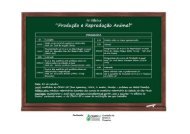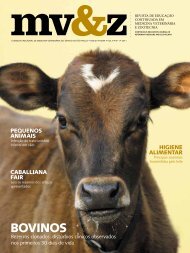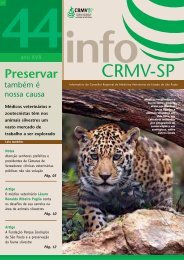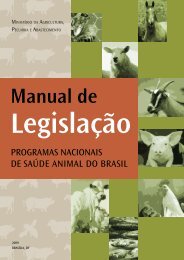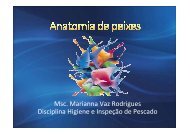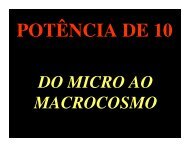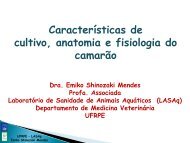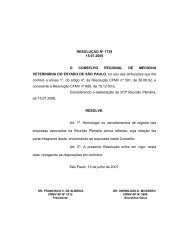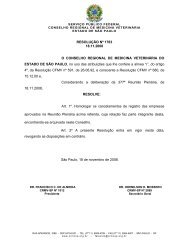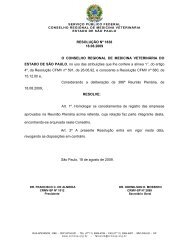mv&z
Vol. 11 - nº 1 - 2013 - CRMV-SP
Vol. 11 - nº 1 - 2013 - CRMV-SP
- No tags were found...
Create successful ePaper yourself
Turn your PDF publications into a flip-book with our unique Google optimized e-Paper software.
X X I I I R I T A B r a z i lPT.103VALORACIÓN DE UN TEST RÁPIDO DEINMUNOCROMATOGRAFÍA EN PLACA PARA LADETECCIÓN DE RABIA EN MUESTRAS FRESCAS Y ENAVANZADA DESCOMPOSICIÓN DE ARGENTINAGury Dohmen F 1 , Barcos O 2 , Cisterna D 3 , Cicuttin G 1 , Mena Segura C 1 ,Beltrán F 4 – 1 Instituto de Zoonosis Luis Pasteur – Diagnóstico, 2 LaboratorioColón, 3 INEI-ANLIS Dr. Carlos Malbrán – Servicio de Neurovirosis,4Instituto de Zoonosis Luis Pasteur, Buenos Aires, ArgentinaEn el presente estudio se evaluó un test de inmunocromatografía (RIDT)para rabia (Rabies Ag Test Kit, Bionote Inc., Korea) de las principales cepasvirales circulantes en la República Argentina, en muestras frescas queincluyeron a los reservorios más frecuentes, como así también en cerebros enavanzado estado de descomposición bajo condiciones de laboratorio. Para ellose realizó el diagnóstico sobre un lote de 50 de muestras clínicas frescas porlas técnicas de IFD, RIDT y EBRL entre los años 2011 y 2012. Para evaluar lascepas de Lasiurus sp (V6) y terrestre silvestre (V2) se utilizaron aislamientosen cerebro de ratón, con la intención de incluir en el ensayo las variantesde mayor circulación del país. Posteriormente se descongelaron 5 cerebrosguardados a -70°C de un brote de rabia canina (V1) 2002-2008. La sensibilidaddel test se valoró con una cepa de virus fijo utilizado en la producción devacuna CRL, previamente titulado en ratones de 21 días y RT-PCR en formaparalela. La concordancia del RIDT con la IFD y EBRL fue del 100% y pudodetectarse hasta la dilución 10-4 del virus fijo, que correspondió a 100 DL50 en0,03ml. Existen regiones de explotación ganadera en el norte del país con rabiaparesiante y otras con antecedentes de rabia de ciclo terrestre de difícil accesocerca de la frontera con Bolivia en donde el veterinario del municipio podríarealizar un primer diagnóstico diferencial a fin de dar parte a las autoridadessanitarias y así aplicar rápidamente las acciones de profilaxis correspondientesa los mordidos y luego remitir la muestra a los laboratorios de referencia paraconfirmación y caracterización de la cepa responsable del brote. En nuestraconclusión el RIDT es de uso muy simple y podría ser considerado de sumautilidad en muestras post-mortem bien conservadas o descompuestas quehayan completado el período de estado de la enfermedad.PT.104USE OF PROPIDIUM IODIDE LIKE A CELULAR CONTRASTSTAINING IN THE DIRECT FLUORESCENT ANTIBODY (DFA)TEST FOR THE RABIES VIRUSES DIAGNOSTIC.Iguala-Vidales M 1 – 1 InDRE – VirologiaIntroduction: Rabies remains one of the most important zoonosisworldwide and represents a serious problem in many countries. Into thediagnostic tools the direct fluorescent antibody (DFA) test is a fast and sensitivemethod to diagnosis rabies infection in animals and in humans (1, 3). The test isbased on microscopic examination, under ultraviolet light, impressions, smearsamples of tissue of the hippocampus (flagpole of Ammon), the cerebellumand the medulla or tissue sections; antibodies (IgG) used in the conjugatemonoclonal allow specific and uniform coloring without interference from thefund.In cell biology, propidium iodide is used as a dye contrast that differentiatesthe nucleus from the cytoplasm (intercalates in DNA) (4), there is evidences ofits use in stains for identification of Herpes Simplex Type 1 (5).Goal: Implement the use of propidium iodide in the diagnosis of the rabiesvirus by direct fluorescent antibody (DFA) test Materials and methods:70 Samples were selected: 50 brains: (25 positive samples of varying degrees ofpositivity (1 + to 4 +) and 25 samples negative) and 20 isolates of the rabies virusin mouse neuroblastoma cell (15 positive samples of varying degrees of positivity(1 + to 4 +) and 5 negative samples) of the rabies laboratory samples bank.The direct fluorescent antibody (DFA) test was applied as indicatedby the supplier Anti-Rabies Monoclonal Globulin (IDF, FUJIREBIO.)(DIAGNOSTICS, Inc.); to the end of the test, added 20 μL of the propidiumiodide solution to a final concentration of 0.3 μg/mL (in each imprint of brainor well cell culture) and it was incubated at room temperature for 5 minutes,it was eliminated by rinsing with PBS pH 7.4, let air dry and was added adrop of buffered glycerin pH 8.4; reading was conducted on an magnificationlens fluorescence microscope 10 X and 40 X. The reading was evaluated for4 people; 2 experts in rabies diagnosis and 2 people in the learning process.Results and conclusion: Of the 50 samples brains were obtained thefollowing results; 25 positive samples of varying degrees of positivity (1 + to 4+) and 25 negative samples and all 20 isolates of the rabies virus of in mouseneuroblastoma cell (15 positive samples of varying degrees of positivity (1 + to4 +) and 5 negative samples; all samples coincided with the previously reportedresults. All personnel involved in reading coincided in the ease of identify thenucleus of the cell in the brain imprints as well as in cell culture slides. Becauseof the propidium iodide is used to staining the DNA, were watched the cellsnucleus of red-orange color; likewise facilitated the identification of infectionin the cytoplasm of the cell (in positive cases) by the fluorescent apple greencontrast of the fluorescein isothiocyanate (FITC) fluorochrome, that isconjugated to the monoclonal antibodies targeting the protein of rabies virus.Therefore, it is concluded that the use of propidium iodide does notinterfere in the DFA test it is concluded that the use of propidium iodide doesnot interfere in the DFA test, since all results were identical to the reported inthe samples tested before; the use of propidium iodide is helpful mainly fortechnical staff who do not have experience in identifying cells in imprints andcell culture; the use of propidium iodide allows a contrast which facilitates theidentification of the fluorescence of the rabies virus.c r m v s p . g o v . b rmv&z51




